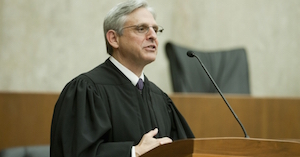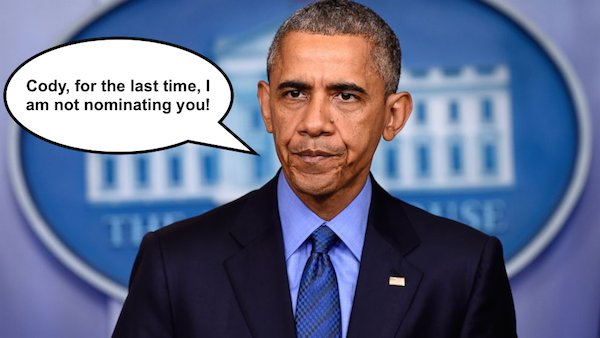Understanding Selection of the Next Supreme Court Justice

President Barack Obama’s recent nomination of Chief Judge Merrick Garland to replace the late Antonin Scalia on the Supreme Court has riveted attention on the Court as well as on the entire process of selecting and confirming justices. In fact, heated debates are roiling not only in Washington D.C. but also on social media and in individual homes across the country as Americans weigh in on whether Chief Judge Garland is the right choice. However, the real question boils down to this: Who determines the next Supreme Court justice?
On the one hand, Republicans call for delaying the confirmation process on the premise that, as it is an election year, they want to allow the next President to make the nomination. Democrats counter with demands that the hearing and vote proceed, citing fairness both to President Obama’s constitutional right to make the selection and the nominee’s right to an up or down vote. With such contradictory perspectives on the matter, Americans can’t be blamed if they are confused about which stance to support.
Yet, amid all the uproar, one salient point remains: Most Americans lack a clear understanding of the methods for selecting and nominating a Supreme Court justice as well as the procedures for confirming one. A few facts regarding the Constitution’s precepts on Supreme Court nomination and confirmation along with a bit of information on the current nominee will arm you with some talking points the next time you enter the fray.
The Nomination Process
Everything begins with the nomination. Since the Constitution stipulates only that the President selects the nominee and the Senate confirms, the President has a good deal of leeway in determining whom to choose. While each President puts his own spin on the process, the commonality is that all of them consider the following factors:
- A potential nominee’s background is scoured during the vetting process, looking for any negative factors that might cause the President to disqualify the nominee as well as analyzing the nominee’s judicial decisions and legal writings.
- The nominee’s judicial philosophy is reviewed as Presidents generally seek a kindred spirit, a nominee whose perspective on the law coincides with that of the President. It may be one of judicial restraint, with its strict reliance on previous decisions so as to uphold the laws as dictated by Congress, or judicial activism, interpreting the laws in accordance with the potential justice’s — and, perhaps, the President’s — strongly held views.
- The nominee’s political party is a component also, with Presidents usually selecting someone of the same political party as the President.
- Diversity, reflecting an attempt to balance the court demographically, sometimes becomes part of the equation as well.
The interesting part is that the nominee need not have a legal background, be of a specific age nor even be American born. It’s totally up to the President to determine who the nominee will be. With all of this in mind, it brings us to the factors weighed by President Obama in nominating Chief Judge Garland to the Supreme Court.
President Obama’s Nomination of Judge Garland

In his weekly address on March 19, 2016, President Obama outlined several elements of both character and expertise that played roles in his decision to nominate Merrick Garland to the Supreme Court:
- Judge Garland’s unmatched experience and integrity, which have earned him the respect of both parties
- As a young lawyer, he left a lucrative private firm to work for half as much in public service.
- Everywhere he went, during his investigation of the Oklahoma City bombing, he carried with him in his briefcase the program from the memorial service, with each of the victims’ names inside.
- For the last 19 years, Judge Garland has served on the second highest court in the land, including the last three years as chief judge.
- On the bench, he has shown a conviction that powerful voices must not be allowed to drown out those of everyday Americans.
- He displays an understanding that justice is not just abstract legal theory; it affects people’s daily lives.
- He has shown a spirit of decency, modesty and evenhandedness in his work.
These are what President Obama deemed to be Judge Garland’s qualifying characteristics, but he also shares a common bond with several justices that came before him.
The Road from the U.S. Court of Appeals for the District of Columbia to the Supreme Court
Interestingly, if confirmed, Chief Judge Garland will not be alone among justices for whom the U.S. Court of Appeals for the District of Columbia Circuit has served as a steppingstone to the Supreme Court. This group includes the following current justices:
- Chief Justice John Roberts
- Associate Justice Clarence Thomas
- Associate Justice Ruth Bader Ginsburg
Additionally, Associate Justice Antonin Scalia was among three other previous justices who also arrived at the Supreme Court by way of the D.C. Court of Appeals:
- Chief Justice Fred M. Vinson
- Chief Justice Warren Burger
- Associate Justice Wiley Blunt Rutledge
Merrick Garland, the Man and the Jurist
Merrick Garland’s backstory is worth noting. After attending Harvard on a scholarship, and graduating summa cum laude, he went on to attend Harvard Law School, which he paid for by tutoring and working as a clerk in a shoe store. He graduated magna cum laude. Clerking first for Second Circuit Judge Henry Friendly and then for Justice William Brennan, Garland followed this up by working in private practice, representing those who were disadvantaged, prior to a stint as a federal prosecutor.
It was while later serving in the Justice Department as Principal Associate Deputy Attorney General — including leading the investigation of the Oklahoma City bombing and subsequent prosecution of Timothy McVeigh — that Garland came to the attention of President Bill Clinton, who selected him for a judgeship on the U.S. Court of Appeals for the District of Columbia Circuit. That was 1997, when qualifications superseded partisan politics, enabling Judge Garland to be confirmed by a vote of 76-23.
Separating Merrick Garland, the man, from Chief Judge Merrick Garland is virtually impossible. The values and character that define the man are inextricably intertwined with the way Chief Judge Garland is viewed by others. The fact that he kept in touch with the Oklahoma City bombing victims and their families, not only during the case but after it as well, is often cited, reflecting his compassion for others as well as the integrity he brings to his work. These qualities are among the many reasons that Judge Garland has received such strong bipartisan support over the years.
Underscoring his commitment to the law and to being worthy of the people’s trust, Judge Garland was quoted in a recent CNN article as saying, “People must be confident that a judge’s decisions are determined by the law and only the law . . . Fidelity to the Constitution and the law has been the cornerstone of my professional life.”
Confirmation Process for the Supreme Court
In view of the fact that Chief Judge Garland’s 19 years on the D.C. Circuit court gives him more federal judicial experience than other Supreme Court nominee have ever had, he is already personally known by many of the current justices and he has been publicly lauded by people on both sides of the aisle over the years, you might expect his confirmation to be a cinch. Think again. As it turns out, confirmation is a process that has become mired in political theater.
Although the Constitution does not expressly state any procedures for Senate confirmation, a few steps have become customary:
- The Senate Judiciary Committee receives the nomination and requests both personal and professional information from the nominee via a questionnaire on finances, employment, legal decisions and writings as well as biographical details.
- The Committee then holds hearings, which the nominee may attend and at which the nominee usually makes a statement before answering questions.
- The Committee then votes and sends the nomination to the full senate, where the same procedures occur.
A simple majority is enough for confirmation, and the nominee is then sworn in at the White House by the Chief Justice.




